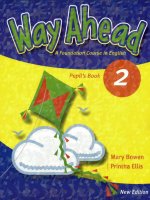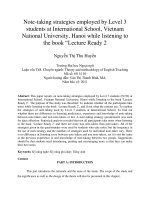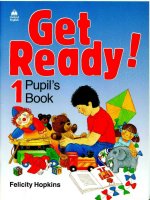get ready 2 pupils book
Bạn đang xem bản rút gọn của tài liệu. Xem và tải ngay bản đầy đủ của tài liệu tại đây (20.74 MB, 65 trang )
Pupil's
Book
Felicity Hopkins
Note
Most of the activities in this book are oral. The words printed
in black are there to guide the teacher. Only the words or
letters printed in a colour are for the pupil to read or
recognize.
Oxford University Press
Notes for the teacher
Get Ready! aims to give pupils a feel for
English and to establish a sound basis for
later learning. Pupil's Book 2 can be
used alone or in conjunction with the
Activity Book, Handwriting Book and
Numbers Book. A cassette has recordings
of all the dialogues and songs in the Pupil's
Book. Where an item has been recorded a
cassette symbol (B) appears in the Pupil's
Book.
Get Ready! 2 is divided into sixty steps. A
step consists of one page in the Pupil's
Book, one page in the Activity Book, and
half a page in each of the Handwriting and
Numbers Books. The sequence for a
complete step is as follows:
Pupil's
Book
Handwriting
Book
Activity
Book
Numbers
Book
Oral work
Most of the work based on Pupil's Book 2
is oral. Only the words or letters printed in a
colour are for the pupil to read. The words
in black are there to guide the teacher.
The pictures are to help the pupil, and the
teacher should encourage the pupils to
point to the pictures when reciting rhymes
or singing songs. The expressions shown in
the Language Summary do not all appear
in the text of the Pupil's Book, but they
should be used orally by the teacher. The
Picture Practice pages are designed to
practise vocabulary and these expressions.
The Teacher's Book provides detailed
notes on when to introduce them.
Reading
In Get Ready!2 pupils will consolidate their
recognition of the small letters and extend
their knowledge of whole words. They are
also introduced to the capital alphabet and
will read a few simple sentences. These
first reading skills are developed in both the
Pupil's Book and the Activity Book.
The approach
The teacher should use choral and
individual repetition and question and
answer routines. Whenever possible, pupils
should take on the role of the teacher and
ask the questions. Games, such as the one
in Step 10, are particularly suitable for this.
The songs are a very important element
of Get Ready! and teachers should
regularly use songs from earlier in the
course. While singing, pupils should point
to the pictures or perform the suggested
actions. These reinforce meaning as well
as make learning more enjoyable. Do not
expect pupils to understand every word in
the songs.
Accuracy
Do not be too concerned about accuracy.
Get Ready! progresses slowly and pupils
will gradually become aware of small
differences and more able to imitate the
teacher's model. Never try to explain
language rules to very young learners.
Mother tongue
Most of the lesson should be in English but
do use the pupils' own language when it
would be helpful. You might use it, for
example, when explaining a game or the
meaning of a song.
Language summary
Functional areas
Expressions
Vocabulary
Steps
1-15
Revision of Book 1
Location
Revision of Book 1
What is your name ?
Where is ... ?
Revision of Book 1
Capital letters
on/under
Numbers 11, 12
Steps
16-30
Location
Ability
I can ...
in
Furniture
Parts of the face
Verbs of movement:
run, jump, hop etc
Steps
31-45
Ability
Co-Co can ...
Numbers 13-20
Farm animals
Family
Steps
46-60
Preference
Revision
Jack likes ...
I like ...
Revision
Clothes
Food
Revision
ISBN-13: 9780194339193
© Oxford University Press 1989
The moral rights of the author have been asserted
Database right Oxford University Press (maker)
First published 1989
2009 2008 2007
Typeset by Pentacor Limited, High Wycomb, Bucks
Printed in China
ACKNOWLEDGEMENTS
Illustrated by: Ray and Corinne Burrows
STEP I
Look and say
What is your name?
What is your name?
/ am Jack.
My name is Ann.
How old are you?
How old are you?
/ am five.
/ am three.
Song
How old are you?
What is your name?
/ am six. I am Sue.
What is your name?
What is your name?
My name is Sue.
What is your name?
STEP 2
Game
What is number 6?
van
table
bike
balloon
desk
house
bed
shoe
dog
chair
STEP 3
Story
Bingo and the ball
This is Ann.
This is Bingo.
Ann is sad. Listen.
Bingo has a little ball.
Bingo has my ball.
Ann is happy.
Bingo is my friend.
STEP 4
Letters
Song
The name song
Ann is a name.
It has a big letter,
A big letter,
A big letter.
Ann is a name.
It has a big letter,
A big, big, big, big 'A'.
Bingo is a name.
It has a big letter,
A big letter,
A big letter.
Bingo is a name.
It has a big letter,
A big, big, big, big 'B'.
STEP 5
Letters
Look and say
STEP 6
Picture practice
STEP 7
Read
STEP 8
Song
Read it, write it
d-o-l-l
What is this word?
d-o-l-l
It is doll.
Read it, write it.
What is this word?
Read it, write it.
It is doll.
d . . . o . . . I . . . I . . . doll!
b-e-a-r
What is this word?
b-e-a-r
It is bear.
Read it, write it.
What is this word?
Read it, write it.
It is bear.
b . . . e . . . a . . . r . . . bear!
STEP
Letters
Look and say
STEP 10
Game
What colour is HA7?
Numbers
STEP 11
Look and say
Where is Bingo?
Where is Ann?
STEP 12
Song
Put your hand on your head
Put your hand on your head,
One, two, three.
Put your hand on your head,
A-B-C.
Put your hand on your head,
One, two, three, A-B-C.
Put your hand on your head,
Sing with me.
Put your finger on your arm,
One, two, three.
Put your finger on your arm,
A-B-C.
Put your finger on your arm,
One, two, three, A-B-C.
Put your finger on your arm,
Sing with me.
Put your pencil on your shoulder,
One, two, three.
Put your pencil on your shoulder,
A-B-C.
Put your pencil on your shoulder,
One, two, three, A-B-C.
Put your pencil on your shoulder,
Sing with me.
STEP 13
Letters
Look and say
STEP 14
Song
The mouse is on the cat
The mouse is on the cat.
The mouse is on the cat.
E-l, E-l,
The mouse is on the cat.
(Where is the cat?)
The cat is on the dog.
The cat is on the dog.
E-l, E-l,
The cat is on the dog.
(Where is the dog?)
The dog is on the bear.
The dog is on the bear.
E-l, E-l,
The dog is on the bear.
(Where is the bear?)
The bear is on the box.
The bear is on the box.
E-l, E-l,
The bear is on the box.
(Where is the mouse?)
The mouse is on the cat.
The cat is on the dog.
The dog is on the bear.
The bear is on the box.
E-l, E-l,
The box is on the floor.
STEP 15
Game
My robot is green.
ls it 6HF?
STEP 16
Song
Game
Big alphabet song
Is it black?
Is it Y?
Yes.
Yes.
STEP 17
Look and say
Where is the green doll?
Where is the yellow bear?
In the box
In the cupboard
In the drawer
In the bag
STEP 18
Rhyme
In my room, I have a drawer.
Look, look, look in my drawer
In my drawer, I have a box.
Look, look, look in my box.
In my box I have a key.
Put the key in the lock,
Open the cupboard door.
Is it a cat? Is it a lion
Sitting on the floor?
ROAR!!
MIAOW!!
STEP
Story
Bingo and the mouse
Bingo is on the floor.
Look at Bingo. Look at the mouse. Look at the jug
The jug is on the floor.
Bingo is sad.
Bingo is under a chair.
STEP 20
Song
Where is little Bingo?
Where is little Bingo?
Where is the mouse?
Under a table in my house.
Look at little Bingo,
Chasing the mouse,
Under a table in my house.
Where is little Bingo?
Where is the mouse?
Under a cupboard in my house.
Look at little Bingo,
Chasing the mouse,
Under a cupboard in my house.
STEP 21
Game
Is it a red ball?
Is it on the cupboard?
Is it number 12?









